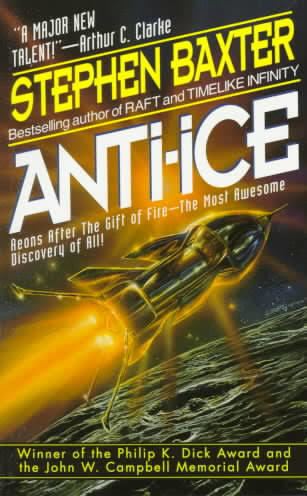Cover artist Chris Moore Language English Media type Print Originally published July 1993 Page count 280 Publisher HarperCollins | Country United Kingdom Publication date July 1993 Pages 280 Followed by The Time Ships | |
 | ||
Genres Fiction, Novel, Alternate history, Science Fiction, Speculative fiction Similar Stephen Baxter books, Science Fiction books | ||
Anti-Ice is a science fiction novel by Stephen Baxter. Published in 1993, it portrays of 19th-century Europe and the changes resulting, particularly in Britain, from an explosive scientific discovery made in the 1850s.
Plot
The novel begins with the text of a letter dated July, 1855 from the Crimean War front of Sevastopol. The writer, Hedley Vicars, tells from his perspective as a soldier in the 90 Light Infantry about the visit to his commanders of one Josiah Traveller, an inventor and millionaire industrialist whose discovery in the South Pole of anti-ice, a substance which releases incredible energies when warmed, is being considered for military use. Soon after that meeting, a mushroom cloud erupts in the midst of Sevastopol and, with its attendant human and structural devastation, quickly ends the war.
This substance originally fell to Earth as the residue of a comet that impacted the far side of the Moon a century ago. Fifteen years after the war, under the reign of Edward VII (who assumed the throne after Queen Victoria abdicated due to her husband Prince Albert's death) and the prime ministership of Gladstone, the United Kingdom maintains through Traveller's discovery a monopoly on the use of anti-ice. But the energy it generates, analogous to nuclear power, is now used to power vehicles and accelerate the country's Industrial Revolution—much to the chagrin of perennial rivals France and a yet-to-be-united Germany.
Junior diplomat Ned Vicars (younger brother of Hedley) and journalist George Holden arrive at Waterloo to view the launch of the Prince Albert, a massive land-going liner supported by six enormous anti-ice driven wheels. Meeting Traveller aboard they inspect his experimental rocket Phaeton. The launch of the Albert is sabotaged, and simultaneously a second saboteur fires the anti-ice rockets of the Phaeton, launching them upward into the air. Breaking free of Earth's gravity, the Phaeton and its reluctant passengers (along with Traveller's manservant Pocket) approach Earth's two moons—as there is now the "Little Moon", broken off when the comet hit Earth's Moon in the eighteenth century. Using the latest in 1870 technology, Vicars mines ice from the surface of the Moon, while encountering simple, massive creatures on its dark side. Converting the water into enough reaction mass to take off, the explorers—along with the saboteur, a Frenchman named Bourne—return to Britain as the Franco-Prussian War breaks out on the continent.
Gladstone meets Traveller personally and orders him forthwith to prepare anti-ice weapons for use to end the war. At first he does so, but Vicars persuades him that such a course of action is unconscionable. Too late, the two arrive in the Phaeton to see the destruction of Orléans by an anti-ice rocket. Peace is immediately declared, and the United Kingdom sets up its hegemony over Europe—a development not without price, which Vicars notes in a 1910 letter to his son. And the supply of anti-ice, which Traveller thought was confined to the South Pole, is virtually limitless due to the "Little Moon", which is composed entirely of anti-ice. The possibilities of an early 20th-century cold war are dwelt on by the narrator (Vicars) throughout the book, the instrument of deterrence being named the Gladstone Shell.
